Alternative names mayo | Course Condiment | |
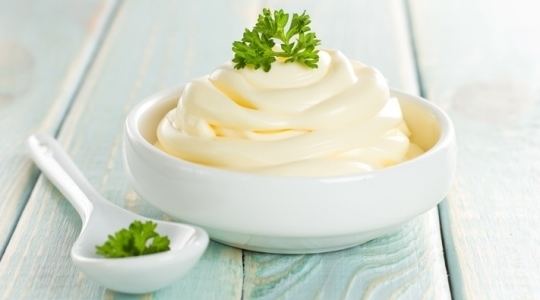 | ||
Main ingredients oil, egg yolk, and either vinegar or lemon juice Similar Mustard, Ketchup, Onion, Cheese, Tomato | ||
Homemade tofu mayonnaise as a vegan sandwich condiment
Mayonnaise (/ˈmeɪəneɪz/, /ˌmeɪəˈneɪz/ or in AmE also /ˈmæneɪz/, and often abbreviated as mayo /ˈmeɪoʊ/) is a thick, creamy dressing often used as a condiment. It is a stable emulsion of oil, egg yolk, and either vinegar or lemon juice, with many options for embellishment with other herbs and spices. Proteins and lecithin in the egg yolk serve as emulsifiers in both mayonnaise and hollandaise sauce. Commercial egg-free alternatives are available for vegans and others who want to avoid animal products and cholesterol, or who are allergic to eggs.
Contents
- Homemade tofu mayonnaise as a vegan sandwich condiment
- History
- Anecdotal origins
- Physical and chemical properties
- Viscoelastic properties
- Freezing mayonnaise
- Preparation
- Microbial spoilage
- Chile
- Europe
- North America
- Japan
- Russia
- As a base for other sauces
- Nutritional information
- References

Mayonnaise varies in color, but is often white, cream, or pale yellow. It may range in texture from that of light cream to a thick gel. In countries influenced by French culture, mustard is also a common ingredient, but the addition of mustard turns the sauce into a remoulade with a different flavor and the mustard acts as an additional emulsifier.

History
The word mayonnaise was not used for a dressing before the start of the 19th century. The earliest reference appears to be by Alexandre Viard (1806), who however never quite gives a recipe for the dressing itself. At that point, the sauce was made with aspic or jelly, rather than an egg emulsion. In 1815, Louis Eustache Ude wrote:
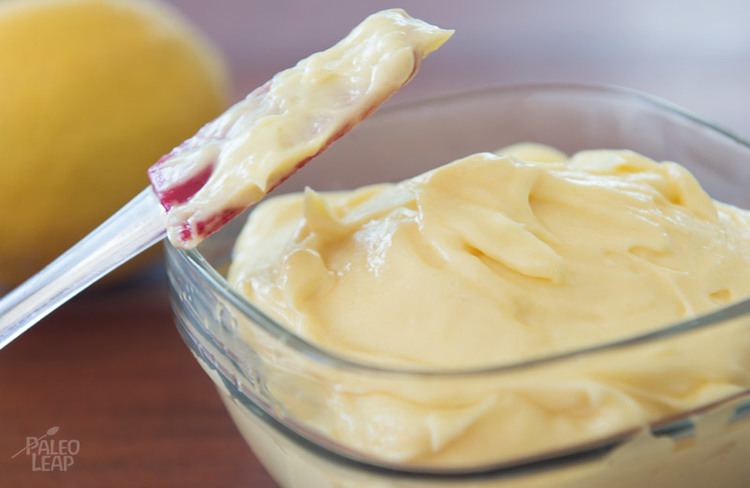
No 58.—Mayonnaise.
Take three spoonfuls of Allemande, six ditto of aspic, and two of oil. Add a little tarragon vinegar, that has not boiled, some pepper and salt, and minced ravigotte, or merely some parsley. Then put in the members of fowl, or fillets of soles, &c. Your mayonnaise must be put to ice; neither are you to put the members into your sauce till it begins to freeze. Next dish your meat or fish, mask with the sauce before it be quite frozen, and garnish your dish with whatever you think proper, as beet root, jelly, nasturtiums, &c.
In a 1820 work, Viard describes something like the more familiar emulsified version:
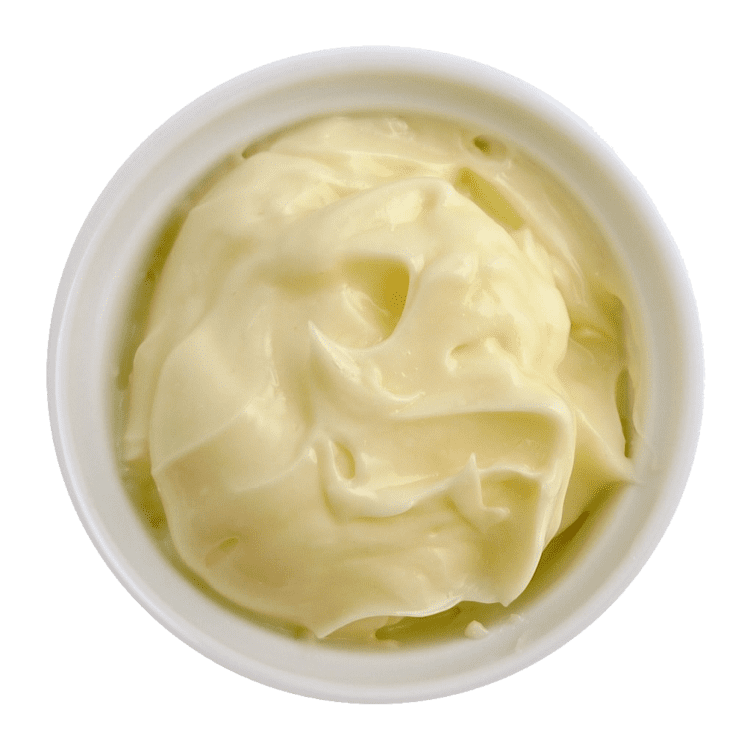
This sauce is made to "take" in many ways: with raw egg yolks, with gelatine, with veal or veal brain glaze. The most common method is to take a raw egg yolk in a small terrine, with a little salt and lemon juice: take a wooden spoon, turn it while letting a trickle of oil fall and stirring constantly; as your sauce thickens, add a little vinegar; put in too a pound of good oil: serve your sauce with good salt: serve it white or green, adding green of ravigote or green of spinach.
This sauce is used for cold fish entrees, or salad of vegetables cooked in salt water.
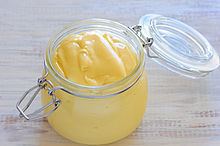
In 1808, Grimod de La Reynière referred to a "bayonnaise" sauce: "But if one wants to make from this cold chicken, a dish of distinction, one composes a bayonnaise, whose green jelly, of a good consistency, forms the most worthy ornament of poultry and fish salads."
Anecdotal origins
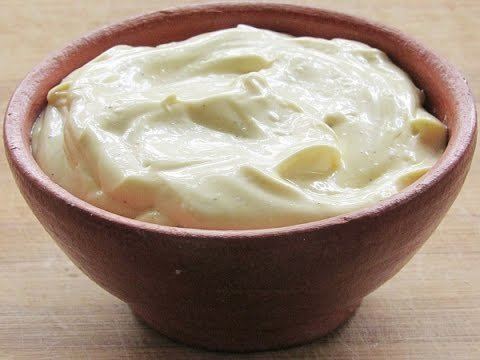
One of the most common places named as the origin of mayonnaise is the town of Mahón in Menorca, Spain, where it was then taken to France after Armand de Vignerot du Plessis's victory over the British at the city's port in 1756. According to this version, the sauce was originally known as salsa mayonesa in Spanish and maonesa (later maionesa) in Catalan (as it is still known in Menorca), later becoming mayonnaise as it was popularized by the French.
The Larousse Gastronomique suggests: "Mayonnaise, in our view, is a popular corruption of moyeunaise, derived from the very old French word moyeu, which means yolk of egg." The sauce may have been christened mayennaise after Charles de Lorraine, duke of Mayenne, because he took the time to finish his meal of chicken with cold sauce before being defeated in the Battle of Arques.
According to Trutter et al.: "It is highly probable that wherever olive oil existed, a simple preparation of oil and egg came about — particularly in the Mediterranean region, where aioli (oil and garlic) is made."
According to the Oxford English Dictionary, the term mayonnaise was in use in English as early as 1823 in the journal of Lady Blessington.
Physical and chemical properties
Traditional mayonnaise is a mixture of egg, vinegar, oil and spices (especially mustard). Mayonnaise made in this fashion typically contains 70–80% fat. Despite the high oil content relative to water, mayonnaise is an oil-in-water emulsion. This emulsion is formed by first mixing the eggs, vinegar and mustard and then slowly blending in the oil. This results in an emulsion consisting of a closely packed "foam" of oil droplets. By contrast, if the oil and aqueous phases are mixed all at once (as many novice cooks can attest) the result is a water-in-oil emulsion similar in viscosity to the oil from which it is made.
Oil may account for 75% or more of the total volume. This means that the oil droplets become distorted from their normal, spherical shape. The close packing of the droplets also allow them to interact very strongly with one another. It is a combination of these factors that gives traditional mayonnaise its high viscosity. The visco-elasticity of mayonnaise made with egg yolk reaches a maximum very quickly after preparation.
For a mayonnaise food system in which emulsifying agent has not been added to the food system yet, the observation is that oil floats on top of water forming two separate layers. Energy as mechanical force (e.g. shear shaking) must be supplied into the system to force the oil to enter the water phase as oil droplets. Energy is needed for the process because the state of unprotected oil droplets in water is thermodynamically unfavorable (ΔG of the process is positive).
When hydrocarbon molecules (oil) are forced into water layer, hydrogen bond of water molecules and some dispersion forces between hydrocarbon molecules must have been destroyed, and new water-hydrocarbon interaction must have been formed in this state. Considering Enthalpy change of the process, the input energy to reach this state and the released energy break even rendering enthalpy change of zero (ΔHsolution =0) for the process. Enthalpy change equals zero also means that the thermal Entropy change ΔSthermal is also about zero for the process. However, positional Entropy change for the process (ΔSpositional) is negative. This is because when oil droplets are in water medium, those water molecules that are in contact with the hydrocarbon molecules lose their freedom of movement. If oil droplets are not in water phase, more water molecules would be more freely to move instead of having restriction on their arrangements. Thus, it is a thermodynamically favorable process for the pure, unprotected oil droplets to move out of water medium as the process is driven forward by Entropy.
Phase separation of oil and water is not only Entropy-driven, but is also driven forward to undo the increase in contact area between oil and water. Forming extra interfacial layer, as when oil droplets are in the water layer, increase the overall energy of the oil-water system. This is because water and oil molecules at the interface are higher in energy compared to when they are in the middle and are surrounded on all directions by their own molecules. Thus, oil droplets would move out of water phase, after letting the mixture sit for a little, to get the change in interfacial area (ΔA) as small as possible in order to minimize the energy rise of the system (ΔG). The relationship between free energy change of a system and its interfacial area is expressed in the equation:
ΔG = γΔA
where ΔG is the increase in surface free energy, ΔA is the increase in surface area, and γ is the interfacial tension between the two liquids.
Emulsifying agent (lecithin) used in mayonnaise are able to suspend oil droplets in water because it lowers the interfacial tension γ between oil and water. When emulsifying agent, lecithin, is added to the oil and water emulsion, they are adsorbed onto the interfacial layer in a manner that their hydrophobic tail point toward the non-polar oil droplet, and their hydrophilic end facing the polar water molecules. In the presence of lecithin, the interfacial tension γ is lower as now water molecules is not in contact with hydrocarbon molecules at the interface anymore. Hence, a large increase of surface area (ΔA) is made possible because energy cost to arrive at the food state is now favorable.
Mayonnaise emulsions eventually break as the oil droplets coalesce, although the kinetics and the precise mechanisms by which the droplets coalesce are not fully understood. As samples of mayonnaise age, the size distribution of the oil droplets changed to produce fewer, larger droplets which eventually led to separation of the phases of the mayonnaise. The shift in droplet size could be measured either microscopically (through light or scanning electron micrographs) or by a decrease in the absorbance at 500 nm. When mayonnaise is stored at elevated temperatures, increases in Brownian motion of the droplets, decrease in the viscosity of the continuous phase, and solubilization of the surfactants all contribute to the breakdown of the emulsion.
Two unprotected oil droplets with small radii in water are favored thermodynamically to coalesce into one bigger droplet because the process yields a smaller surface area-to-volume ratio. The energetic contribution of the interfacial layer over that same volume of oil is minimized when the two droplets fuse together. Thus, the coalescence process puts the system in a lower energy state and the process would occur spontaneously. However, when the oil droplets are coated with emulsifying agent, electrostatic repulsive force is introduced among the oil droplets which keeps the droplets from coming together.
Manufacturers usually try to reduce the oil content of mayonnaise as much as possible within the limits of the food regulations of the country the mayonnaise will be sold in. This is because the oil is usually the most expensive component of mayonnaise. Unfortunately, reducing the proportion of oil in mayonnaise reduces the density of the oil droplets. This means that the interactions between droplets are weakened and the emulsion becomes less stable. In the absence of strong inter-droplet interactions, low-fat emulsions separate under gravity in accordance with the Stokes equation:
where v is the creaming velocity, g is the acceleration due to gravity, r is the radius of the droplets, and ρ and η are the density and shear viscosity, respectively, of a given phase. The subscripts 1 and 2 refer to the continuous and dispersed phases, respectively. Stability of a medium-to-low-fat emulsion can be increased by reducing the size of the droplets, which also produces a product with a lighter, "creamier" appearance. Another possibility is to increase the viscosity of the continuous phase, and various products including proteins, dextrins and gums are available for this purpose.
Viscoelastic properties
As a semi-solid, mayonnaise has an extremely high viscosity and because of this, its flow properties have been studied extensively. Shear stress is an important term when discussing liquids and solids at any viscosity and is defined as the force per unit area that is required to drag one layer of substance past another layer. Rheology is the study of science that deals with the flow and deformation of matter and is an umbrella for a few of mayonnaise's properties. One of which includes yield stress which can be defined as a minimum shear stress required to initiate flow. So, with all of these terms now defined, one can look at the specific properties that mayonnaise possesses. Mayonnaise has a high shear stress with a typical yield stress around 100 Pascals). For reference, ketchup has a yield stress of about 15 Pascals. With such a high yield stress, mayonnaise is able to resist low forces and even return to its original conformation. A simple equation can be written to explain the relationship between these terms:
In this equation, au is equal to the shear stress, au_0 is equal to the yield stress, gamma is the shear rate and k & n are model parameters that influence the shape and curvature of the stress/rate curve. Mayonnaise happens to be a Bingham fluid where k is equal to the plasticity constant and n is equal to 1. This equation is in the form of y=mx+b and thus produces a straight line. In more laymen's terms, the yield stress is the tipping point for conformational change in the mayonnaise after initial force is applied and it is held constant.
Freezing mayonnaise
Mayonnaise is an oil in water emulsion which is stable at room temperature because it reaches phase equilibrium. At freezing temperatures, the structures inside of mayonnaise undergo crystallization depending on the type of emulsion. Butter is a water in oil emulsion with the water phase having a higher freezing point than oil. In the freezer, the small water droplets that are suspended in the continuous oil phase freeze in their specific locations while the rest of the oil stays in place. When the butter is needed, one only needs to take it out of the freezer and thaw it for the general properties of butter return as the water droplets melt in their respective locations. Mayonnaise is different; when oil in water emulsions are frozen, the continuous phase is water which freezes and allows the oil droplets to flocculate. This whole process causes a phase separation between the water and the oil.
Once ice crystals start to form in the continuous water phase, they begin to inhibit the lecithin and phospholipids from working. These two emulsifying agents lose their functionality due to dehydration: water is crystallizing with itself and is leaving these agents "out to dry." The oil droplets begin to flocculate without the emulsifying agents keeping them separated. At water's freezing point, this is enough to destabilize the mayonnaise emulsion but at even lower temperatures, the fused oil droplets reach their freezing points and fat crystal nucleation begins. Mayonnaise therefore, should not be stored at frozen temperatures due to their thermodynamic instability. Freezing of the water phase in mayonnaise is catastrophic to the stability and shelf-life of the entire product.
Preparation
Mayonnaise can be made by hand with a mortar and pestle, whisk, or fork, or with the aid of an electric mixer or blender. It is made by slowly adding oil to an egg yolk, while whisking vigorously to disperse the oil. The oil and the water in yolks form a base of the emulsion, while lecithin and protein from the yolks are the emulsifiers that stabilize it. A combination of van der Waals interactions and electrostatic repulsion determine the bond strength among oil droplets. The high viscosity of mayonnaise is attributed to the total strength created by these two intermolecular forces. Taste and further stabilize the emulsion, as mustard contains small amounts of lecithin. If vinegar is added directly to the yolk, it can emulsify more oil, thus making more mayonnaise.
For large-scale preparation of mayonnaise where mixing equipment is being employed, the process typically begins with the dispersal of eggs, either powdered or liquid, into water. Once emulsified, the remaining ingredients are then added and vigorously mixed until completely hydrated and evenly dispersed. Oil is then added as rapidly as it can be absorbed. Though only a small part of the total, ingredients other than the oil are critical to proper formulation. These must be totally hydrated and dispersed within a small liquid volume, which can cause difficulties including emulsion breakdown during the oil-adding phase. Often, a long agitation process is required to achieve proper dispersal/emulsification, presenting one of the trickiest phases of the production process. Though, as technology in the food industry advances, processing has been shortened drastically, allowing roughly 1000 liters to be produced in 10 minutes.
Microbial spoilage
Both commercially processed mayonnaise and home-made mayonnaise has been associated with illnesses from Salmonella globally. The source of Salmonella is confirmed to be from the raw eggs ingredient. Several outbreaks with fatal cases have been recorded with a few major incidents. In 1955, there was an outbreak in Denmark with 10,000 people affected with Salmonella from contaminated mayonnaise made from a large kitchen. The pH of mayonnaise was found to be 5.1 with Salmonella count of 180,000 per gram. The second outbreak also in Denmark has 41 infected cases in total with 2 fatalities. The pH of the contaminated mayonnaise was 6.0 with 6 million counts per gram. In 1976, there were serious salmonellosis outbreaks on four flights to and from Spain which caused 500 ill cases and 6 fatalities. In the US, 404 people became ill and 9 people died in a New York City hospital due to hospital-prepared mayonnaise. In all Salmonellosis cases, the major reason was due to the improper acidification of the mayonnaise in which the pH level was higher than the recommended value of 4.1 or lower, with acetic acid as the main acidifying agent.
Nutrient content of mayonnaise (>50% edible oil, 9-11% salt, 7-10% sugar in the aqueous phase) is suitable as food source for many spoilage organisms, the set of condition such as (low pH of 3.6 to 4.0, low water activity aw of 0.925) restricts the growth of yeasts, a few bacteria and molds. Yeasts of the genus Saccharomyces (Lactobacillus fructivorans and Z. bailii) are the species that responsible for the spoilage mayonnaise. The characteristics of spoilage caused by Z.bailli are product separation and a “yeasty” odor. A study suggests that adding encapsulated cells of Bifidobacterium bifidum and B. infantis prolongs the life of mayonnaise up to 12 weeks without microorganism spoilage.
Chile
Chile is the world's third major per capita consumer of mayonnaise and first in Latin America. Mayonnaise became widely accessible in the 1980s.
Europe
Guidelines issued in September 1991 by Europe's Federation of the Condiment Sauce Industries recommend that oil and liquid egg yolk levels in mayonnaise should be at least 70% and 5%, respectively. The Netherlands incorporated this guideline in 1998 into the law Warenwetbesluit Gereserveerde aanduidingen in article 4. Most available brands easily exceed this target.
North America
Commercial mayonnaise sold in jars originated in Philadelphia in 1907 when Amelia Schlorer decided to start selling her own mayonnaise recipe originally used in salads sold in the family grocery store. Mrs. Schlorer's mayonnaise was an instant success with local customers and eventually grew into the Schlorer Delicatessen Company. Around the same time in New York City, a family from Vetschau, Germany, at Richard Hellmann's delicatessen on Columbus Avenue, featured his wife's homemade recipe in salads sold in their delicatessen. The condiment quickly became so popular that Hellmann began selling it in "wooden boats" that were used for weighing butter. In 1912, Mrs. Hellmann's mayonnaise was mass-marketed and later was trademarked in 1926 as Hellmann's Blue Ribbon Mayonnaise.
Japan
Japanese mayonnaise is typically made with apple cider vinegar or rice vinegar and a small amount of MSG, which gives it a different flavor from mayonnaise made from distilled vinegar. It is most often sold in soft plastic squeeze bottles. Its texture is thicker than most Western commercial mayonnaise.
Apart from salads, it is popular with dishes such as okonomiyaki, takoyaki and yakisoba and may also accompany katsu and karaage.
Kewpie (Q.P.) is the most popular brand of Japanese mayonnaise, advertised with a Kewpie doll logo. The vinegar is a proprietary blend containing apple and malt vinegars.
Russia
Mayonnaise is very popular in Russia, where it is made with sunflower seed oil. A 2004 study showed that Russia is the only market in Europe where mayonnaise is sold more than ketchup by volume. It is used as a sauce in the most popular salads in Russia, such as Olivier salad (also known as Russian salad), dressed herring, and many others. Leading brands are Calve (marketed by Unilever) and Sloboda (marketed by Efko).
As a base for other sauces
Mayonnaise is the base for many other chilled sauces and salad dressings. For example, sauce rémoulade, in classic French cuisine, is mayonnaise to which has been added mustard, gherkins, capers, parsley, chervil, tarragon, and possibly anchovy essence.
Nutritional information
A typical formulation for commercially made mayonnaise (not low fat) can contain as much as 80% vegetable oil, usually soybean but sometimes olive oil. Water makes up about 7% to 8% and egg yolks about 6%. Some formulas use whole eggs instead of just yolks. The remaining ingredients include vinegar (4%), salt (1%), and sugar (1%). Low-fat formulas will typically decrease oil content to just 50% and increase water content to about 35%. Egg content is reduced to 4% and vinegar to 3%. Sugar is increased to 1.5% and salt lowered to 0.7%. Gums or thickeners (4%) are added to increase viscosity, improve texture, and ensure a stable emulsion.
Mayonnaise is prepared using several methods, but on average it contains around 700 kilocalories (2,900 kJ) per 100 grams, or 94 kilocalories (Cal) per tablespoon. This makes mayonnaise a calorically dense food.
Egg-free versions of mayonnaise are available for vegans and others who want to avoid eggs, animal fat, and cholesterol, or who have egg allergies. In the U.S., these alternatives cannot be labelled as "mayonnaise" because of the FDA's definition of mayonnaise making egg a requirement.
Well-known brands include Nayonaise and Vegenaise in North America, and Plamil Egg Free in the UK.
In August 2015, the United States Food and Drug Administration sent out a warning letter to the San Francisco company Hampton Creek, objecting to the name of their "Just Mayo" product, which is not egg-based, so does not meet the U.S. legal definition of "mayonnaise".
Egg-free mayonnaise is expected to contain soya or pea protein instead of lecithin in egg yolk as emulsifying agent to stabilize oil droplets in water.
